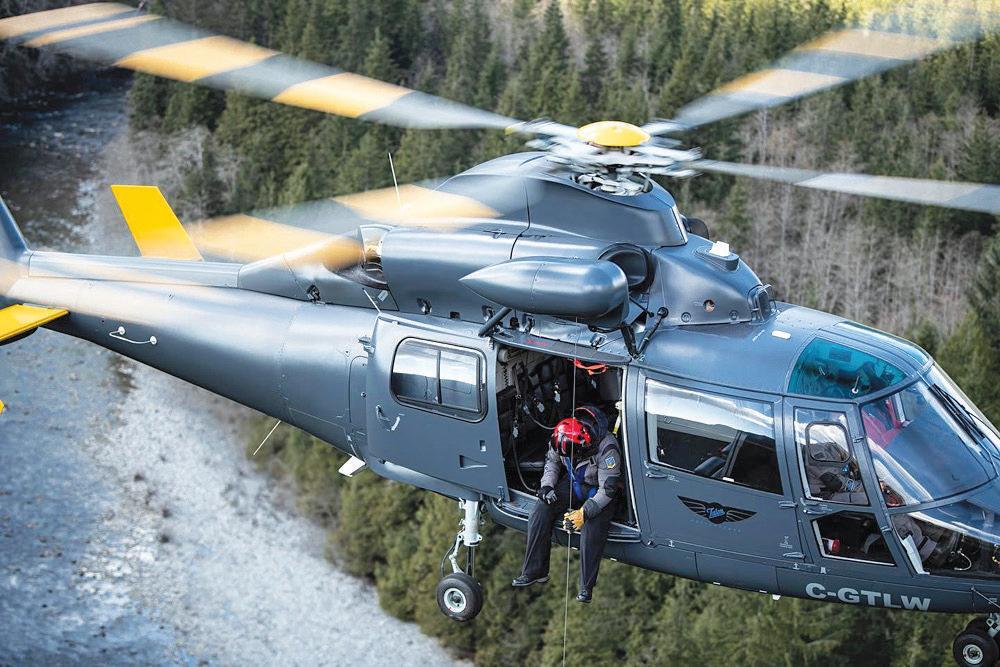






















BRENTRICHTER

brichter@nsnewscom
North Shore Rescue was called upon 142 times in 2022,asmallreprieveaftertherecord-smashing226 theyearbefore
But even with fewer missions into the mountains, it doesn’tmeanthevolunteershavebeengettingrusty,said teamleaderMikeDanks

Teammembersputinabout4,100hourswhileonrescue tasks,accordingtoNSR Theyloggedanother2,600hours in training time and, though the team doesn’t officially track the time put into administrative, public education and maintenance tasks, there’s something like another 4,000hoursthere.

And even with call volumes down, 142 is still extremely busy–only2021,2020and2018hadhighervolumes “It really ebbed and flowed and we certainly had some busy times,” Danks said “Even when we’re really busy, we’restillmanaging.…Beingbusyiskindofagoodthing forus”
The return to more “normal” call volumes in 2022 is likely related to the end of COVID-19 restrictions, which curtailedmostindoorrecreationactivitiesin2021,Danks said It was also a quieter year for wildfires, which the teamissometimesaskedtohelprespondto.
Just under half of the calls in 2022 involved the use of a helicopter Thanks to Talon Helicopters’ acquisition of an Airbus AS365N2 Dauphin with night-vision flying capabilities and a hoist, rescues in difficult terrain are becoming far more efficient, Danks said They made use ofthenightvision13times.Thehelicopter’shoistwasput towork21times

After years of push-and-pull with the province, NSR was finally given approval to use both their night vision and hoist tech simultaneously in October. They carried out theirfirstnighthoistrescuejustbeforeChristmas “[The Dauphin] changed the way that we’re responding to calls and it’s really made things a lot safer I think that’sbeenabigpivotforusaswe’renolongerrushingto beatdaylight,”hesaid
InJuly,theteamsetarecordforthefastesteverhelicopter rescue–38minutesfromthetimetheywerealertedtoa hikerhavingcardiacissuesonSt Mark’sSummittowhen hewashandedovertoB.C.AmbulanceService.
“That’s when it really sunk in about how quick and efficientwe’vebecome,”hesaid.



Deaths in the backcountry always weigh heavily on the team,Dankssaid,butamazingly,therewerenofatalities on the trails or mountaintops within North Shore Rescue’sturfin2022 Theyearbefore,therewereseven Dankssaidhe’dliketothinkofthatasatestamenttothe work of the team along with the police and fire agencies they work with He also expressed hope that efforts in trail safety education are paying dividends. More initiatives aimed at preventing people from getting into troubleinthefirstplacewillbeabigfocusinthecoming years,Dankssaid
“Wewanttofrontloadourinvolvementinthecommunity atayoungerage,ifwecan,”hesaid
On nine occasions, the team was mobilized to help in urbansearchesforseniorsorpeoplewithdementiawho hadwanderedoff.
Danks said his biggest fear is donations tailing off The team relies on donations to keep members certified, which requires constant training, and well equipped Some of the team’s biggest pieces of infrastructure are startingtocrumbleandarebadlyinneedofreplacement In addition to their rescue commitments, day jobs and personallives,Danksandotherteammembersmustalso search out sponsors and donors to keep their mission going.
”WEREALLYNEEDCONSISTENT FUNDINGONAREGULARBASIS, REGARDLESSOFOURCALLVOLUME, BECAUSETHOSEEXPENSESARETHERE ALLTHETIME.THEYDON’TGOAWAY.”

“Ireallywanttostresstopeoplethatwearesofortunate thatwegetsuchincrediblesupportfromthecommunity,” he said “We really need consistent funding on a regular basis, regardless of our call volume, because those expenses are there all the time. Theydon’tgoaway”
Donations can be made at northshorerescuecom
Looking back, Danks said he swells with pride when he thinks of the achievements his membersmadeinthelastyear
“I have to express my appreciation for the dedication and commitment of the membership Theyalonehavemadethis a seamless year. 2022 may have only been 140-some calls, but they all went extremely well,” he said “We have new leaders emerging in this team and the futurelooksbright.”
”[THEDAUPHIN]CHANGEDTHEWAY THATWE’RERESPONDINGTOCALLS ANDIT’SREALLYMADETHINGSALOT SAFER.ITHINKTHAT’SBEENABIG PIVOTFORUSASWE’RENOLONGER RUSHINGTOBEATDAYLIGHT.” Goldenretriever Dukeiscarriedoff MountSeymourtoa waitinghelicopterby membersofNorth ShoreRescue RYANMORASIEWICZ/NSR NorthShoreRescue volunteershelpa groupofhikersoutof theNorthVancouver backcountrynear GrouseMountain NSR




JANESEYD Jseyd@nsnews.com

Thereareplentyofplacesinthebackcountrywhere things are more likely to go wrong than right. The backside of Hollyburn Mountain in high avalanche terrainisoneofthem.
It’salsowhereanout-of-boundssnowboarder got caught inanavalancheearlierthismonth,breakinghisleginthe process Though his friend pulled him out, hypothermia begantosetin,justasthelightwasfading.


When things go badly wrong in the North Shore mountains, among the first people heading in are members of North Shore Rescue’s advanced medical provider resource team Made up of 12 emergency room or ICU doctors, anesthesiologists and a nurse, the team combines advanced emergency medical skills with experienceandtraininginbackcountrymountaineering. Medical personnel on the team also must live on the North Shore, so they can be ready to head out at a moment’snotice
Of the 12 people currently on the team, seven doctors and one nurse work regular jobs at Lions Gate Hospital, while four doctors work out of Royal Columbian in New Westminster
Dr Alec Ritchie and registered nurse Kayla Brolly are team leaders of the medical resource team who are both alsoregularmembersofNorthShoreRescue
“The common denominator for all the AMPs is we’re all
mountainpeople,”saysRitchie “Sowe’reallcomfortable onskis,orcramponsorropesandthatsortofthing.”
Ritchie, an emergency department doctor who is also a professor of emergency medicine at UBC, is also part of theWhistlerskipatrolasanembeddedphysician Brolly, who grew up on the North Shore, also spent time as a ski patroller before becoming a rapid attack forest firefighter, where she rappelled out of helicopters into danger. When she started nursing school at UBC, Brolly decidedtovolunteerwithNorthShoreRescueasawayof continuingtouseherskills Shehasn’tlookedbacksince, including providing medical help at an NSR SAR station twodaysbeforegivingbirthtoherdaughter
”THECOMMONDENOMINATORFOR ALLTHEAMPSISWE’REALLMOUNTAIN PEOPLE.SOWE’REALLCOMFORTABLE ONSKIS,ORCRAMPONSORROPES ANDTHATSORTOFTHING.”
About40percentofNorthShoreRescuecallsaremedical calls.Ofthose,about25to30percentareserious.Itcould be a serious bone fracture, chest pains, a heart attack, someonewhoisfallingunconsciousorshowingsignsof acollapsedlungorinternalbleedingafterafall
Sometimes there’s a mental health issue – someone’s drunkorhigh,paranoidorsuicidal Thereisno“typical”call.


But just as an example, says Ritchie, consider the “boot top tib/fib fracture” – what happens if a skier falls over and snaps their leg at the top of their ski boot “Sometimes the bone’s even sticking out of the skin ThenputyourselfinthebackcountryofSeymour”
down to a doctor or nurse’s own clinical skills “When you’rethere,youhavetomake whateveryouhavework,”says Ritchie.
The advanced medical provider program is unique in Canada.InEurope,suchteamsaremuchmorecommon, said Ritchie – with one big difference. “In Europe you’re a paid professional That is your job, to do helicopter mountainmedicine Wejustdoitforfree”



Today, their capability rivals any search team in the world
“We have the medications and the equipment to essentiallybringanintensivecareunittothemountains.”
Among the equipment they often carry: monitors, a defibrillator, a CPR machine that does chest compressions, oxygen, IV tubing, breathing tubes and evenahandheldportableultrasound
Beyond the technical gear and medications, knowing as muchaspossibleaboutwhatthey’rewalkingintohelps.
Once in the field, however, a lot of critical care comes

Emergency medicine on the sideofamountainslopeinthe dark will never be the same as it is in hospital “When the technical complexity of the mission increases, the medical care must decrease Something has to give,” says Ritchie “If they’re on the side of the mountain on ice and it’s -10 and we’re helicopter longlining, that’s a technical mission. I can’t be doing a lot of medicine. I must stabilize the patient and get out of Dodge.”
“There’s a lot of medical decisionmakingonwhatdoweneedtodoimmediatelyand what can wait until we get to somewhere warmer, drier, betterlit.”
Brolly points to a call in September as one where the medicalteammadeallthedifference Inthatcase,Brolly used a portable cardiogram to diagnose a major heart attack in a hiker suffering severe chest pains at the top ofMountStrachan Knowingcardiacemergenciesshould be handled at certain specialist hospitals, they flew the man straight into Vancouver Harbour for transfer to St Paul’sER

“That’sacasewherethisprogramismakingadifference,”
On behalf of West Vancouver-Capilano constituents, we thank the skilled members of North Shore Rescue for volunteering your time and energy to keep us safe all year round.
she said. “If it was 10 years ago and we didn’t have this technology and this level of care, it could have gone a differentdirection.”
Not every call is a success “Not everybody lives,” said Ritchie “That’shardonus”
Deaths that result from foolish decisions are especially difficult,hesaid,because“thisdidn’tneedtohappen.”
But those days are far outweighed by the satisfaction of makingadifferenceinanenvironmenttheylove
“It’s very gratifying,” says Brolly “Because you’re in these really bad spots with people where no one else is coming It’sjustyouandyourteam”
- Jordan“WEHAVETHEMEDICATIONSAND THEEQUIPMENTTOESSENTIALLY BRINGANINTENSIVECAREUNIT TOTHEMOUNTAINS.”









































NICKLABA


nlaba@nsnewscom


It’simpossibletoseparatethemountainrangesthatdominateourlandscape from the brave volunteers who work to recover people caught in the treacherousterrain.
CathalynnLabonté-Smith’snewbookRescueMetellsthestoriesofsearchandrescue workers across North America Those include the North Shore Rescue helicopter missionsoftenfeaturedinthepagesofthisnewspaper,aswellasrescuescarriedout




continuedonpage35
AuthorCathalynn Labonté-Smith haswrittena bookthatgoes behindthe scenesofsearch andrescue operationsacross NorthAmerica, includingNorth ShoreRescue PAULMCGRATH/NSN












NICKLABA

nlaba@nsnewscom
It may be the last week in January, but it’s not too latetopickupafun2023calendarthatpaystribute toNorthShoreRescuewithsomecheekycartoons. That’s12monthsofjokes,indelibleNorthShorecredand tinyboxesthatyoumayormaynotwritethingsin,allfor US$19.95 (I might need rescuing if I check the exchange raterightnow) Allproceedsfromyourpurchasegoright toNSR,supportingthecriticalworktheydothere
The witty panels were drawn by legendary Vancouver SuncartoonistGrahamHarrop.


“Each one of them resonates with us and tells a bit of a

story,”teamleaderMikeDankssaidinaninterviewwhen thecalendarwasfirstreleasedlastyear.
But while the laughs are needed by the team, so is the extraboostoffunding
Dankssaidthattheadditionofnighthoisting–approved inOctober–introducessignificantexpenses
“It’sacostlyventure,butweknowit’sonethatwillmake a very positive difference, not only for the safety of our members,butforthecommunityasawhole,”hesaid CartoonistHarropsaidhehopesthecalendargivespeople alaughandbuildssupportfortheteam’svitalwork “LivingontheNorthShoremakesyoumoreawareofwhat NSR volunteers do,” he said. “Cartoon ideas came from newsstories,andincludingthebearsgave risetohumoroussituations Thecartoonof thebearpromisingnottorootthroughthe garbage echoes my concern for our North Shorebruins”

Youcanbuythecalendarvia ArtWantedcom
Thisimagecomesfroma
2023calendarthatsupports
NorthShoreRescue.Legendary VancouverSuncartoonist GrahamHarropdrewthe cartoons,withallproceeds goingtothevolunteergroup
GRAHAMHARROP

By recounting their most memorable experiences,Labonté-Smithunderscores the huge emotional weight associated with the work, and the resilience requiredofsearchandrescuemembers
The author said she became interested in the topic after her husband Stephen started training for Sunshine Coast Search and Rescue in 2020 That same year, the docuseries Search and Rescue:NorthShorewasreleasedbythe KnowledgeNetwork.
Labonté-Smith wondered: Why isn’t thereabook?
She knew about search and rescue operations in BC, but wanted a more completeperspective.“SoIcontactedall thesearchandrescueinNorthAmerica that I could possibly find,” LabontéSmith. “Anyone who responded, I interviewed.”
Divided into sections based on rescue types, the book includes SAR members in Ontario, Washington, California, Colorado and Maine, as well as British Columbia.
Labonté-Smith said she wants to make people aware of the work and that it’s beingdonebyvolunteers
“I don’t want to suck the joy out of people’s adventures,” she said. “I just would like them to reflect on these stories, and maybe apply some of the lessonslearnedtotheirownpractices”
A number of pages are dedicated to North Shore Rescue, the largest SAR organization in Canada, and its team leader Mike Danks An account in the “avalanches”sectionofthebookrecalls oneofDanks’shardestcalls.





After a long career of being a stoic firefighter and SAR member, Mike remembers his life-changing call-out a few days before Christmas in 2013 on UnnecessaryMountainaboveLionsBay.
Seven-year old Erin Moore, her sister and her mother were hiking with a large group About halfway into the tenkilometre hike, there was a rockslide on thetrail Erinwasstruckbybouldersand covered by debris. The group unburied her and performed CPR. Nurses who had hiked in by foot, and a helicopter withadoctorandaparamediconboard, cametoErin’said.Unfortunately,despite all their efforts, Erin was pronounced deceasedatthescene
“I looked into her eyes,” said Mike, who was one of the rescuers trying desperately to save the little girl. Later thatevening,ashetuckedhisownsevenyear-old daughter into bed, he looked intohereyesandwasdeeplyshaken
Labonté-Smith writes how the stress from balancing his job, volunteering at NSR and raising three kids all peaked in that moment of sorrow He dealt with his breakdown by attending a resilientmind retreat, available through the fire department It reset his life, and he could finally talk aboutthehorrificcallslikeErin’s

“It was a game changer for me I could bring it back to my colleagues at the fire department and at NSR – that you don’t needtobeafraidtotalkaboutthetough calls” His breakthrough moment was when he realized that for the sake of his mental health, he didn’t need to go to everycall-out.
Callsinvolvingchildrenare particularly hard,Labonté-Smithsaid

“When that kind of call comes in, everybody is on high alert and puts everything into it – like they do every call But when it’s a child, even more so,” she explained. “It’s more traumatizing, and the [critical incident stress management] teams come in, if there’sapooroutcome.”
Danks has come back from that. “They don’t like using words like heroic and hero, but it’s hard not think of those wordswhenyouthinkofMike.”